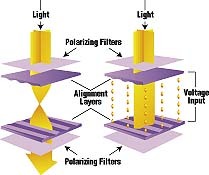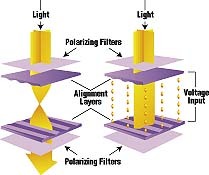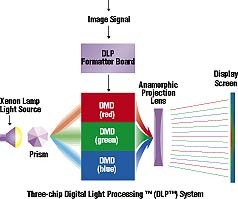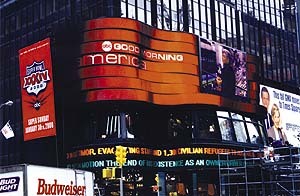To children of the 1950s and ’60s, large-format video typically involved drawing the window blinds and balancing Dad’s rattletrap movie projector on a stack of books. In those days, grainy home movies and balky film reels gave video projectors a bad name. The first generation of fuzzy, projection-type TVs hardly improved this reputation. Today, however, sophisticated optics and digital electronics combine to bring projection displays back to the forefront of moving-message technology.
The next time you attend a hockey or basketball game, see your favorite rock group or view a corporate presentation, what you think is a TV screen might bear a close resemblance to that roll-up antique Dad bought with his old movie projector. In terms of picture quality, however, video projection is an entirely new ballgame.
LCD displays
Liquid crystal diodes (LCDs), commonly found in digital wristwatches, calculators and laptop-computer screens, are the active components in a new generation of full-color projection displays. For all the talk about LCDs, however, relatively few people understand how they work.
LCDs are also known as "twisted nematic devices." In these diodes, liquid crystal (nematic) molecules are sandwiched between two transparent electrodes (usually glass slides coated with a conductive material). Each electrode’s surface is also coated with a thin layer of polymer that is rubbed or brushed in one direction to create tiny grooves. Elongated liquid-crystal molecules naturally align themselves parallel with these grooved surfaces. Two polarizing filters are arranged so that the polarizing axis of one is perpendicular to the axis of the other. Liquid crystals between the filters assume a twisted helix structure (Fig. 1) when no voltage is applied. This molecular arrangement acts as an optical-wave guide, directing light completely through the cell and giving it a transparent appearance.
When voltage is applied to the electrodes, however, the liquid-crystal molecules lose their twisted structure, aligning with the electrical field. This causes the cell to lose its optical-wave-guiding property, blocking passage of light and making it appear dark. An electronic driver switches individual cells between clear and dark states to create the display.
In LCD-projection systems, projectors incorporate high-resolution, active-matrix LCD panels. The projector’s bright light source beams the integral LCD displays onto a large screen. Grand-format presentations typically require several projectors.
DLP technology
Digital Light Processing (DLP


 Photo Gallery2 weeks ago
Photo Gallery2 weeks ago
 Paula Fargo1 week ago
Paula Fargo1 week ago
 Real Deal1 week ago
Real Deal1 week ago
 Photo Gallery1 week ago
Photo Gallery1 week ago
 Projects1 week ago
Projects1 week ago
 Women in Signs2 weeks ago
Women in Signs2 weeks ago
 Signs of the Times2 weeks ago
Signs of the Times2 weeks ago
 Business Management6 days ago
Business Management6 days ago






















